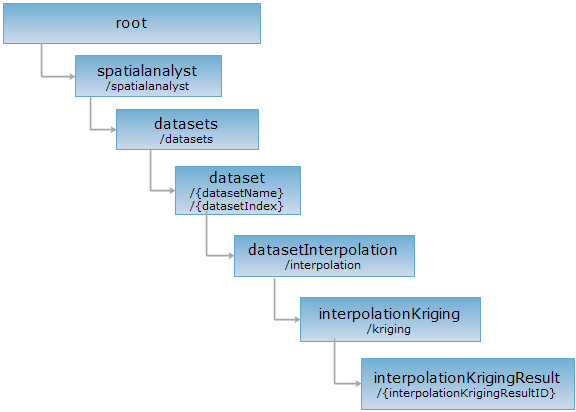
<interpolationKriging_uri>/{interpolationKrigingResultID}[.<format>]
Kriging interpolation result resource, used to get the result of the first-order Kriging interpolation.
Supported methods
Supported output formats: rjson, json, html, xml.

Below is an example of performing an HTTP request on a specified URI with rjson as the output format. supermapiserver in the URI is the name of the server.
http://supermapiserver:8090/iserver/services/spatialanalyst-sample/restjsr/spatialanalyst/datasets/SamplesP@Interpolation/interpolation/kriging/imv6lfcx_e581cc63597d49e59e18fb73d84a5553
Returns Kriging interpolation analysis result resource.
Normal response code(s): 200.
| Name | Type | Description |
| succeed | boolean | Whether the interpolation analysis is successful. |
|
message |
String | The information returned when the interpolation analysis failed. |
| dataset | String | The ID of the result dataset. |
| recordset | Recordset | The result record set for storing information of the spatial objects. |
Implement GET request on the result resource of interpolationKriging resource POST results: http://localhost:8090/iserver/services/spatialanalyst-sample/restjsr/spatialanalyst/datasets/SamplesP@Interpolation/interpolation/kriging/imv6lfcx_e581cc63597d49e59e18fb73d84a5553.rjson, the response in rjson format is as follows:
{
"dataset": "test_Kriging@Interpolation",
"message": null,
"recordset": null,
"succeed": true
}
Asks for the response identical to the one that would correspond to a GET request, but without the response body. This is useful for retrieving meta-information written in response headers, without having to transport the entire content. The meta-information includes the media-type, content-encoding, transfer-encoding, content-length, etc.
HEAD request can be used to check if the interpolationKrigingResult resource exists, or if the resource can be accessed by clients. It can also determine if the interpolationKrigingResult resource supports an output format <format> if performed on a URI with .<format> included.